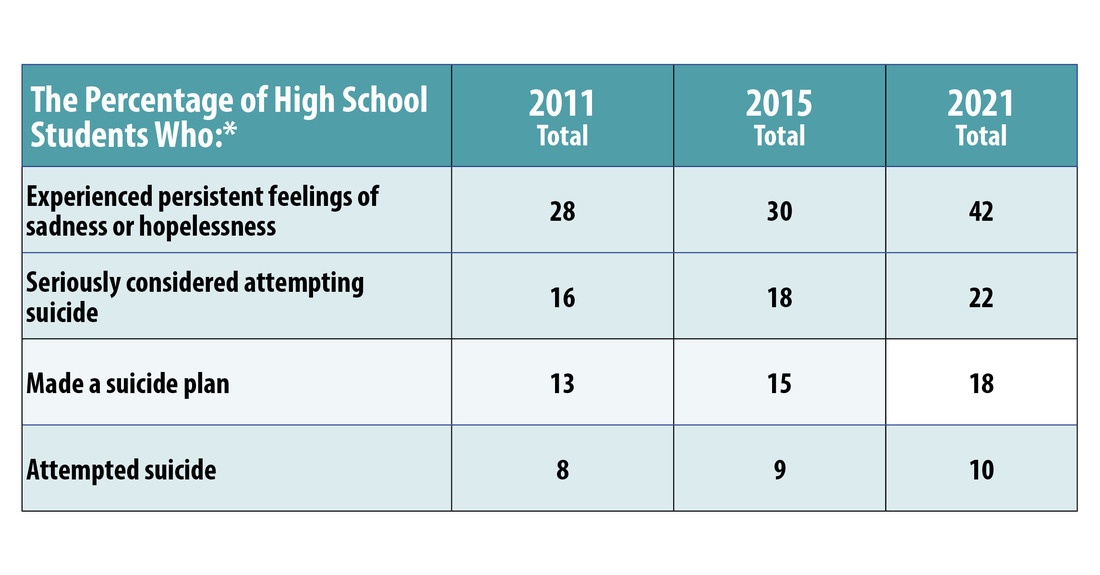
Preteens and teens have a lot to contend with. They’re likely going through a lot of physical changes, learning more about themselves, wanting to branch out and exert their will, becoming more aware of social situations, feeling pressure academically or in extracurriculars, and more.
Add a kid’s mental health struggles to the mix, and that’s a difficult load to manage. And even if a child or teen doesn’t have a preexisting mental health condition, all of those pressures may contribute to a mental health disorder.
The Centers for Disease Control and Prevention (CDC) mental health statistics in youth indicate that America is experiencing a child and teenage mental health crisis, which has worsened from 2011 to 2021, according to the most recent CDC report.
What percentage of children experience a mental health disorder each year?
At least 1 in 5 kids ages 9 to 17 currently have a diagnosable mental health disorder that causes some impairment in their daily life. Approximately 1 in 10 youth ages 9 to 17 live with a mental health disorder that causes significant impairment to their lives.
While it is more typical that older kids and teenagers are diagnosed with a mental health condition, kids as young as 3 are still diagnosed with common kids’ mental health disorders.
And the number of children and adolescents experiencing mental health struggles is only increasing. Consider these takeaways from the CDC’s Youth Risk Behavior Survey Data Summary & Trends Report, which looked at teenage mental health statistics, overall health behaviors and experiences among high school students in the United States between 2011 to 2021. The following are youth mental health statistics from that report.
- Nearly all indicators of poor mental health and suicidal thoughts and behaviors that youth reported increased between 2011 to 2021.
- In 2011, about 28% of high school students said they experienced persistent feelings of sadness or hopelessness. In 2021, that number increased to 42% of students.
- In 2011, about 16% of students in 2011 said they seriously considered attempting suicide and 8% attempted suicide. In 2021, 22% of students seriously considered suicide and 10% attempted suicide.

How does mental health affect teens?
Mental health can affect teens’ short- and long-term overall well-being since mental health can also take a physical toll. Here are some of the ways mental health concerns can be signaled.
- Lack of interest in people, activities or hobbies they used to enjoy
- Lethargy
- Sleep too much or too little
- Have extreme changes in appetite and activity levels
- Have periods of greatly elevated energy and activity and require much less sleep than usual
- Isolate and avoid family and friends
- Significant mood changes
- Consistent irritability or sadness
- Diet or exercise excessively or fear gaining weight
- Smoke, drink, or use drugs, alcohol or other substances
- Engage in risky or destructive behavior alone or with friends
- Talk about or otherwise indicate thoughts or actions of self-harm or suicide
- Say that they think someone is trying to control their mind or that they hear things other people can’t
- Experience academic or social struggles

What is the hardest mental illness to live with?
It’s difficult to compare any one mental health condition to another because how symptoms and the severity of those symptoms affect one child may differ wildly from how they affect another.
However, it can be harder to address mental health conditions that younger children experience because communication barriers can make it difficult to discern that they are experiencing a condition and what the root causes may be.
Additionally, some of the most common mental health issues in young adults are more likely to have comorbidity, or occur at the same time as others. For example, about 3 in 4 U.S. children and adolescents who have depression also have anxiety. Of those who have an anxiety disorder, more than 1 in 3 also had behavior issues and about 1 in 3 also had depression.
How to help a teenager with mental health issues?
Because childhood and adolescence include a lot of developmental milestones, it’s critical to get kids connected to professionals who can help so they don’t fall behind their emotional, physical or cognitive milestones and let the issue snowball.
A mental health provider like Heart of Iowa Community Services (HICS) can help assess your child’s and family’s unique needs and connect you to resources close to home that help kids and teens improve mental health. No one has to suffer in shame or silence.
Reach out at HICSIowa.org.
